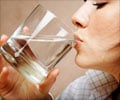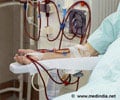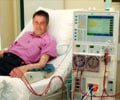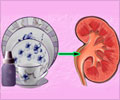Highlights:
- A new portable sensor device has been developed to measure hydration levels accurately
- The noninvasive device can help patients with kidney diseases, congestive heart failure and dehydration
- The device uses the same technology that magnetic resonance imaging (MRI) scanners are based on
Read More..
Dialysis and Hydration Levels
Patients who develop end-stage kidney failure require dialysis in order to maintain balance in the body by removal of waste, salt and excess water. It is crucial to remove fluids at the correct rates and stop at the right time, and in order to do this the amount of water that has to be removed should be known. The patient will also require careful monitoring to know sudden drops in blood pressure. Bringing the patients to their ‘dry weight,’ the weight, at which their fluid levels are optimized, is one of the important goals of dialysis. However, determining the dry weight is highly challenging and doctors use physical signs and trial-and-error over multiple dialysis sessions to estimate it.Presently in the US, there are about half a million people on dialysis; however, there is no easy, reliable way to measure hydration levels in these patients. The methods currently used are invasive, unreliable or subjective. Hypervolemia or fluid overload is assessed by doctors by way of physical signs like examining the size of the jugular vein, pressing on the skin or probing the ankles where water might pool.
Hydration Sensor Device
A research team from MIT and Massachusetts General Hospital has now developed a portable sensor device to accurately measure patients' hydration levels using a technique called nuclear magnetic resonance (NMR) relaxometry. This device, in addition to helping dialysis patients, could also benefit those with congestive heart failure, athletes and elderly who may be prone to dehydration. The device uses the same technology that the magnetic resonance imaging (MRI) scanners use, but provides information faster and at a lower cost as there is no imaging involved.Dr. Michael Cima, Professor of Engineering in MIT's Department of Materials Science and Engineering and a member of MIT’s Koch Institute for Integrative Cancer Research, is the senior author of the study. “There's a tremendous need across many different patient populations to know whether they have too much water or too little water. This is a way we could measure directly, in every patient, how close they are to a normal hydration state,” says Dr. Cima.
The paper appears in the issue of Science Translational Medicine and the lead author is Dr. Lina Colucci, a former graduate student in health sciences and technology. Matthew Li – a graduate student from MIT; Kristin Corapi, Andrew Allegretti, and Herbert Lin – Nephrologists from MGH; Xavier Vela Parada – MGH research fellow; Dennis Ausiello – MGH Chief of Medicine; and Matthew Rosen – Assistant Professor in Radiology at Harvard Medical School are the other authors.
New Approach
Dr. Cima began working on the project around 10 years ago when he realized that the need for an accurate, noninvasive way to measure hydration was highly significant. A new approach based on NMR was chosen by the MIT team. In T2 Biosystems, a company Dr. Cima had previously launched, small NMR devices were used to diagnose bacterial infections by analyzing blood samples of patients. Dr. Cima came up with the idea of using such devices to measure water content in tissue.A few years ago, the team got a grant from the MIT-MGH Strategic Partnership to conduct a small clinical trial for monitoring hydration. Patients with end-stage renal disease who were on dialysis regularly and healthy controls were studied. The MIT-MGH team was able to show that more accurate information on dry weight could be provided by quantitative NMR, which works by measuring T2 relaxation time, a property of hydrogen atoms. Both the environment and quantity of hydrogen atoms present could be measured by the T2 signal.
“The beauty of magnetic resonance compared to other modalities for assessing hydration is that the magnetic resonance signal comes exclusively from hydrogen atoms. And most of the hydrogen atoms in the human body are found in water molecules,” says Dr. Colucci
Fluid volume in patients before and after they underwent dialysis was measured by the research team using the device.
The results exhibit that this technique has the potential to tell apart healthy patients from those requiring dialysis right after the first measurement. Additionally, the measurement could also show the dialysis patients correctly moving closer to a normal hydration state during the course of their treatment.
The Way Forward
Additional clinical trials with dialysis patients are being planned by the research team. Dialysis, which currently costs the US more than $40 billion per year, is expected to be one of the biggest applications for this technology. Monitoring of this kind could also benefit around 5 million other people in the country with congestive heart failure.“The water retention issues of congestive heart failure patients are very significant,” Dr. Cima says. “Our sensor may offer the possibility of a direct measure of how close they are to a normal fluid state. This is important because identifying fluid accumulation early has been shown to reduce hospitalization, but right now there are no ways to quantify low-level fluid accumulation in the body. Our technology could potentially be used at home as a way for the care team to get that early warning,” he added.
While studying the healthy controls, the research team incidentally also found that the device could detect dehydration. This feature could benefit in monitoring the elderly who frequently become dehydrated as with age their sense of thirst would have lessened. Similarly, athletes participating in marathons or other endurance events could also use the device to check hydration.
The research team also planned for future clinical trials to test their technology's potential to detect dehydration.
Reference:
- Hydration sensor could improve dialysis - (http://news.mit.edu/2019/hydration-sensor-dialysis-0724)
Source-Medindia
















